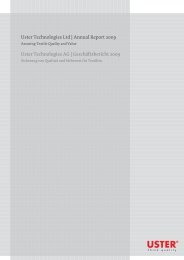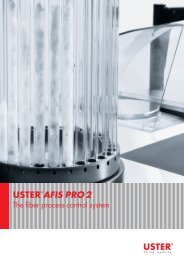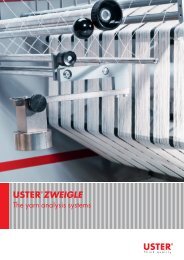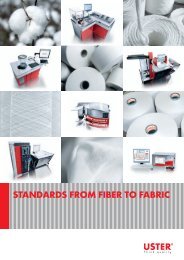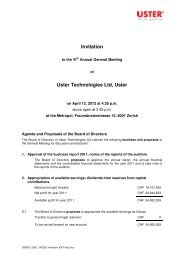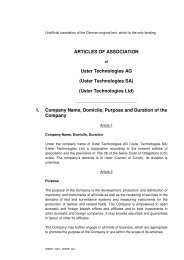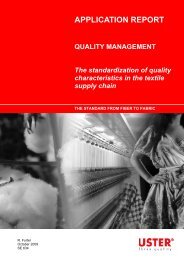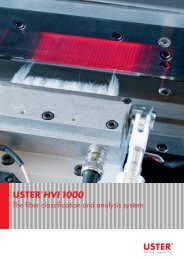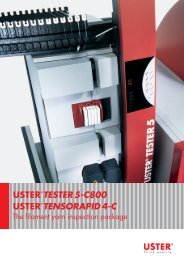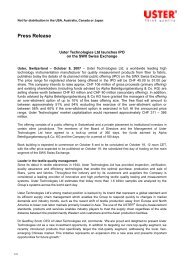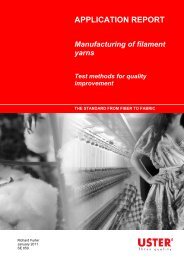Application Handbook_Uster_Statistics - Uster Technologies
Application Handbook_Uster_Statistics - Uster Technologies
Application Handbook_Uster_Statistics - Uster Technologies
- No tags were found...
You also want an ePaper? Increase the reach of your titles
YUMPU automatically turns print PDFs into web optimized ePapers that Google loves.
5.5 Outliers and Frequent Defects in a Spinning MillIt is a popular illusion that yarns with a high rating according to the USTER ® STATISTICS are alwaysabove and beyond suspicion. A good overall quality does not only encompass excellent mean valuesbut also low variability of the quality attributes as well as unconditional consistency. Only one badpackage in the creel of a knitting machine or in warping is bound to ruin several hundred meters ofgreige fabric. We have come a long way in gaining control over sporadic yarn defects by on-linequality monitoring and over scattered weak places by applying the USTER ® TENSOJET. Every nowand then, however, various off-quality situations tend to recur with malicious persistence in spite ofthe blind faith often put in the USTER ® STATISTICS ratings. These include outliers, mix-ups,overlength/underlength or damaged packages, problems with package unwinding behavior, missingtransfer tails, improper waxing, shedding and fly, dye streaks (barré), white specks – just to name afew. Quality in a broader sense has many dimensions: A truckload of 5% USTER ® STATISTICS yarnthat arrives too late at the weaver’s loading ramp will not be considered a quality product. Timing isvital due to the seasonal characteristic of the textile business with its frequent peak demands and, ofcourse, due to the increasing popularity of just-in-time and quick response production.5.6 Restrictions in Guarantee AgreementsThe issue of performance guarantees negotiated between yarn producers and machinerymanufacturers has already been briefly touched upon. Such performance guarantees based on theUSTER ® STATISTICS must be considered a dubious practice when the effect of raw material,machine settings, maintenance, ambient conditions, and operator proficiency is neglected. Alegitimate performance guarantee should include references to in-depth technological trials conductedprior to preparing such a document. It should also embrace technically sound prohibitive clauses thatserve to preclude misunderstandings – or even worse – litigation between machinery manufacturersand yarn producers. In the majority of all cases, it is not the machine that produces poor quality. If itwould not have to process a capricious material like textile fibers, the average textile machine wouldprobably run uninterruptedly for ten, fifteen years or more without any major problems at all. Beforemaking claims against machinery manufacturers, the potential source of the quality problem as wellas its true nature and extent should be investigated thoroughly and objectively.5.7 Reproducibility and Variability of MeasurementsLast but not least, a few comments on reproducibility and variability of measurements. No matter whatmeasuring instrument is used – from yardstick to atomic clock – there will always be a certainmeasurement error. This is also true for textile testing. There are three types of measurement errors:avoidable error, systematic error (bias), and random error. Avoidable error encompasses the failure tochoose an appropriate measurement method or to properly operate a measuring instrument. In thetextile laboratory, this is of little significance but selecting instrument settings and sample conditioningpresent a potential source of avoidable error. Systematic error includes calibration error, instrumenttolerances, and the fluctuation of ambient conditions. This type of error can be quantified fairlyaccurately. Random error is the most critical component in textile testing. It is predominantly causedby the variability of the tested material itself. Its magnitude can be approximated by statisticalcalculations – the confidence interval of the mean. The absolute error of a measurement is the total ofall three types of errors. A measurement should therefore always be reported as x±∆x, i.e. the meanvalue plus/minus the total error to indicate that the true measurement value is located somewherewithin that interval.USTER ® STATISTICS 33 (36)



